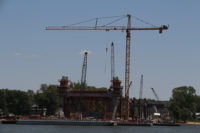November Construction Retreats 11% Nationwide
At a seasonally adjusted annual rate of $524.8 billion, new construction starts in November fell 11% from the previous month, according to McGraw Hill Construction, a division of McGraw Hill Financial.
The downturn followed heightened activity in October, which showed the strongest pace for construction starts so far during 2013. Both nonresidential building and nonbuilding construction pulled back from their elevated October amounts. At the same time, residential building showed modest growth in November, continuing the steady upward trend that’s been present during most of 2013.
For the first 11 months of 2013, total construction starts on an unadjusted basis came in at $475.3 billion, up 6% from the same period a year ago. If the volatile electric utility category is excluded from the year-to-date statistics, total construction starts for the first 11 months of 2013 would be up 14%.
November’s data produced a reading of 111 for the Dodge Index (2000=100), compared to 125 in October and 118 in September. For the first eight months of 2013 the Dodge Index had averaged 105, as it hovered within the fairly narrow range of 100 to 108. While November showed a decline from the prior two months, the level of activity was still above what had been reported earlier in the year.
“The monthly construction start statistics will often show an up-and-down pattern, given the amount of large projects that are included in any given month,” stated Robert A. Murray, chief economist for McGraw Hill Construction. “Although November witnessed a decline from the heightened activity in September and October, the construction start statistics when viewed in the context of 2013 as a whole are still trending upward.
“Housing during 2013 has strengthened on a consistent basis. Nonresidential building is gaining momentum, aided by improving activity for commercial building from low levels, while the institutional building sector stabilizes after a lengthy decline. Nonbuilding construction is weakening due to a sharply reduced amount of new electric utility starts, but its public works component has shown surprising resilience this year,” Murray said.
“For 2014, the upward trend for total construction starts is expected to continue. One plus for construction and the economy going forward is the recent budget pact approved by the U.S. Congress, since it removes the uncertainty that would have come with the threat of another government shutdown in early 2014,” Murray added.
Nonresidential Building
Nonresidential building in November dropped 17% to $179.3 billion (annual rate), following its elevated activity in October. The manufacturing plant category plunged 86%, after being lifted in October by the start of three massive projects each valued in excess of $1 billion. In contrast, the largest manufacturing-related projects reported as November starts were a $94-million biotechnology plant in North Carolina and a $75-million pipe and tube plant in Texas.
Excluding the manufacturing category, nonresidential building in November would have been up 16%, supported by the month’s 31% jump for the commercial building group. Hotel construction in November surged 212%, boosted by $476 million for the hotel portion of the $700-million 67-story Korean Air Hotel in Los Angeles. Also reported as a November start was $191 million for the hotel portion of a $300-million hotel resort and casino in Durant, Okla.
Office construction in November climbed 26%, maintaining the growing momentum that’s been present during the second half of 2013. Large office projects reported as November starts were the $336-million Transbay office tower in San Francisco, the $265-million State Farm office complex in Tempe, Ariz., and $160 million for the office portion of the $700-million Korean Air Hotel project in Los Angeles.
Warehouse construction was particularly strong in November, advancing 82% with the help of such projects as a $90 million distribution facility in Union, Ohio, and an $85-million Amazon distribution center in Kenosha, Wis. Store construction was the one commercial category to decline in November, dropping 23% with the largest project being a $45-million outlet mall in Tejon Ranch, Calif.
The institutional building group in November slipped 3%. Health care facilities fell 41%, sliding back for the second month in a row after a particularly strong amount in September. The largest health care facility projects reported as November starts were a $136-million hospital in Chicago and a $90-million hospital expansion in Long Island City, N.Y. The educational building category in November decreased 8% from its improved pace in October, with the largest education-related projects being a $125-million museum expansion in Potomac, Md., and a $100-million research facility in Maywood, Ill.
The smaller institutional categories showed strong percentage gains in November after a generally weak October. Amusement-related construction advanced 84%, led by the start of the $763-million Vikings Multipurpose Stadium in Minneapolis, as well as $109 million for the casino portion of the $300-million hotel resort and casino in Durant, Okla.
Transportation terminal construction in November rose 13%, supported by $125 million for the redevelopment of the George Washington Bridge Bus Station in New York City. The public buildings and religious categories in November showed large percentage gains from very low October levels, rising 21% and 33% respectively.
During the first 11 months of 2013, nonresidential building climbed 8% relative to the same period a year ago. The commercial categories as a whole were up 16%, featuring these across-the-board gains—warehouses, up 32%; hotels, up 24%; office buildings, up 23%; and stores, up 1%. The 2013 increase for stores was restrained by the comparison to 2012 that included the $400-million renovation to Macy’s flagship department store in New York City. The manufacturing building category year-to-date climbed 49%, helped especially by the three large manufacturing projects reported as October starts.


